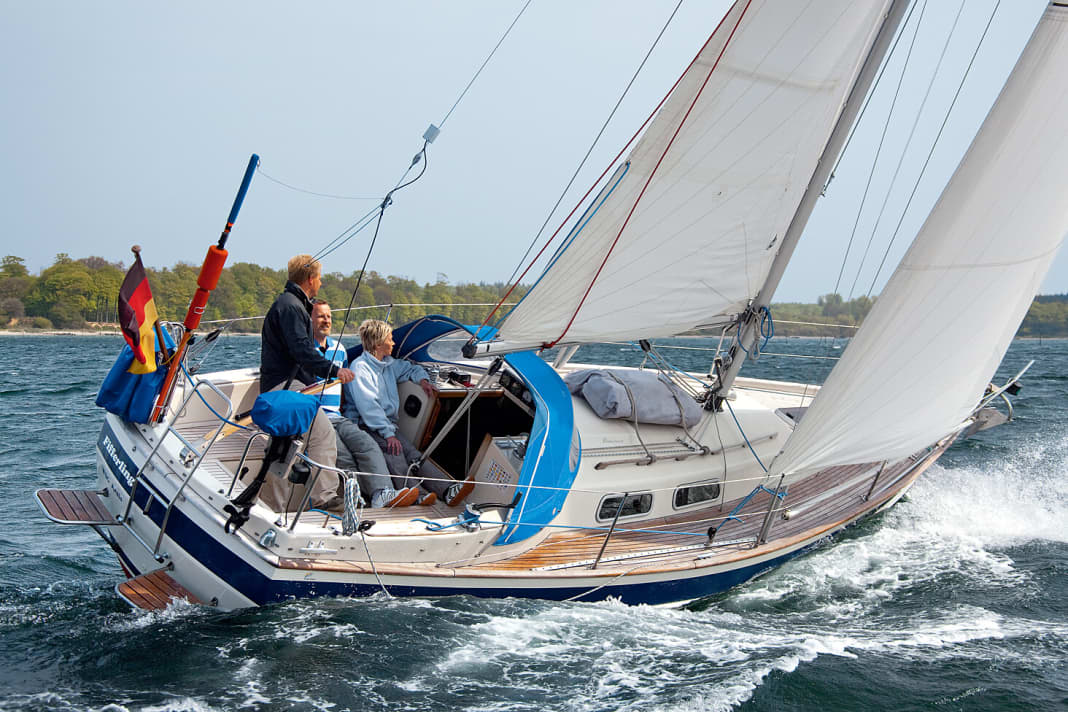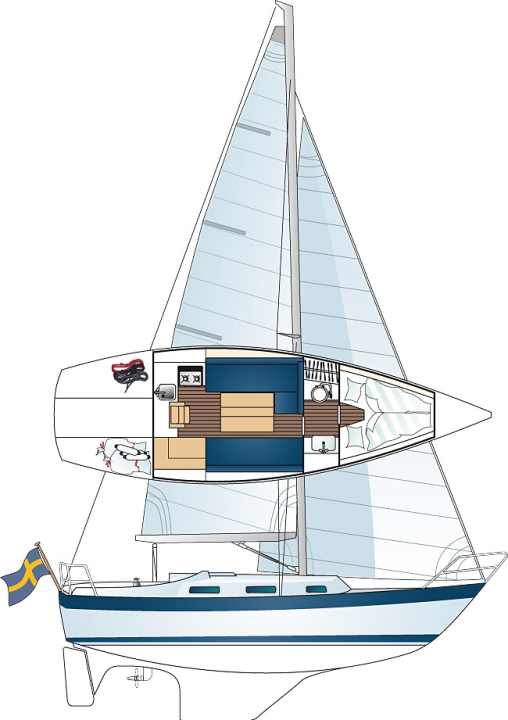





For many, it is the most beautiful of the Hallberg-Rassys designed by Olle Enderlein. Indeed, the lines of the Hallberg-Rassy 29 presented in 1982 are extremely pleasing. It has a flat superstructure, wide, teak-covered running decks and a sheer foredeck. No question, the 29 has class.
The design of the hull with its moderate long keel and skeg-protected rudder was already considered rather conventional at the time. The rig clearly distinguishes the small Hallberg-Rassy 29 from her siblings: instead of a top rig, shipyard founder and co-designer Christoph Rassy and Enderlein opted for a 7/8 rig, which was unusual for cruising yachts at the time. Thanks to the swept spreaders, there are no backstays.
The Hallberg-Rassy 29, which displaces just under four tonnes, cannot necessarily be described as sporty. However, the rig fits the boat extremely well and eliminates the need to deal with overly large and unwieldy genoas. Instead, the cloth surface can be effectively adjusted using the reefing steps of the mainsail.
The Hallberg-Rassy 29 likes wind
As far as that is necessary, because as the external appearance suggests, the Hallberg-Rassy 29 sails extremely well. The narrow beam of well under three metres may make her appear a little slender, but from 25 to 30 degrees she is very stiff in the water and can easily cope with strong pushes. When testing the 28-year-old boat at the time of testing, the wind was blowing at 5 to 6 Beaufort, yet the Hallberg-Rassy 29 was able to carry the full main and the Genoa II upwind without too much rudder pressure. Sailing is wonderfully relaxed. The slim, low-cut foredeck runs comfortably through the steep Baltic wave and the crew is very well protected. Even though the original winches are not self-tailing, they have been correctly dimensioned like the other fittings and are easy to operate. From 1984, the cockpit coaming was also slightly modified and the angle of the genoa sheet was optimised.
Even if the small Hallberg-Rassy 29 proves to be superior in wind and waves, one thing is clear: it is not a flat runner. Below 4 Beaufort, it quickly becomes sluggish and the urge to reach for the Volvo's ignition key becomes more and more pronounced. Nevertheless, the jockey wheel pushes powerfully when required and is also pleasantly quiet thanks to good sound insulation and saildrive propulsion. Up until 1984, an MD7B with 18 hp and single-circuit cooling was installed; newer models were fitted with the successor model in 2002.
The dual-circuit cooling system, which was initially optional, later became standard equipment. In the last build numbers of the Hallberg-Rassy 29, from 1993 onwards, the 29 hp three-cylinder MD2020 provided propulsion. While the manoeuvrability in forward motion is good despite the moderate keel and skeg, the underwater hull has its pitfalls when sailing astern. A little practice is required to steer accurately astern.
The design of the Hallberg-Rassy 29 is solid and practical
There were two versions of the Hallberg-Rassy 29. The most common is the version with four berths distributed over the foredeck and saloon, a chart locker to starboard and three spacious forecastle berths. However, there are also Hallberg-Rassy 29s with an additional dog berth to starboard. For the fifth berth, however, you have to do without a forecastle. In addition, the berth is almost at the same level as the galley work surface due to the shoulder width required.
Cooking is done on the port side next to the companionway, on a two-burner cooker with oven as standard. The gas bottle originally stowed in the anchor locker of the Hallberg-Rassy 29 has since been moved to a container aft by many owners.
The relatively dark mahogany atmosphere of the boat may not be to everyone's taste, but it can be lightened up well with a lighter-coloured upholstery fabric, especially as sufficient light penetrates down through the side windows.
Overall, the finish of the Hallberg-Rassy 29 is solid, and it quickly becomes clear how Hallberg-Rassy's good reputation came about. The woodworking is exemplary, all fittings and components are extremely solid - even if the paintwork of the first years of construction is not quite ideal from today's perspective.
It is amazing how much usable storage and living space is hidden in the slim Hallberg-Rassy 29. Whether in the galley, the saloon, the bathroom or under the forward berth, there are drawers and lockers everywhere.
The quality of the plastic workmanship is just as solid as the interior. The Swedes manufactured the hull of the Hallberg-Rassy 29 using the injection moulding process with additional mat reinforcements. As they used too much rather than too little material, there are no strength problems to worry about. The iron ballast of the keel is fully laminated and therefore protected against corrosion. The deck is also made of injection-moulded laminate, but has a core of PVC foam, so that hardly any damage is to be expected here either. Even if the dry-screwed teak deck should leak, moisture cannot spread through the sandwich.
Only the gelcoat is showing the ravages of time. Many hulls are heavily chalked or, like our test boat, have already been painted.
Hallberg-Rassy 29 is an investment property
In addition to the general condition, the engine type and its age are the main reasons for price differences. They are never really cheap. Depending on the year of manufacture, offers vary from just under 40,000 euros to just under 50,000 euros.
Whether the money is well invested naturally depends on the owner's preferences. However, anyone looking for a solid, carefree cruising boat should include the HR on their shortlist. After all, there is a chance that the resale value will remain high, making the HR an investment alongside sailing pleasure.
The weak points of the Hallberg Rassy 29
Even the best designs show wear and tear after decades. But it is surprising how well the Swede defies decay. Basically, there is only one typical weak point: play in the lower rudder bearing on the skeg. This does not cause any strength problems, but the rattling is annoying when sailing.
Of course, typical age-related problems such as damaged teak deck joints or plugs falling out also occur with the HR. Nevertheless, the PVC foam core prevents damage to the deck laminate, and the material thickness of the teak usually allows it to be overhauled.
The situation is more difficult with the built-in machine. The single-circuit cooled versions of the MD7B, which were initially installed, have often reached the end of their service life. Anyone interested in an HR with this engine should definitely consult a specialist and have the cylinder head dismantled. This is the only way to find out for sure whether the machine can be repaired or whether it needs to be replaced.
YACHT review of the Hallberg Rassy 29
The superior sea behaviour makes the HR 29 look like a larger yacht. The used price is high, but is relativised by the solid substance and resale value
Design and concept
- + Solid substance
- + Good-natured cruising boat
Sailing performance and trim
- + Decent sailing characteristics
- - Sluggish in light winds
Living and finishing quality
- + Good wood processing
- + Plenty of storage space
Equipment and technology
- + Solid fittings
- + Large engine compartment
The Hallberg Rassy 29 in detail

Technical data of the Hallberg Rassy 29
- Design engineer: Olle Enderlein
- Lüa (torso length): 8,90 m
- LWL (waterline length): 7,25 m
- Width: 2,83 m
- Depth: 1,59 m
- Weight: 3,8 t
- Ballast/proportion: 1,75 t/46 %
- Mainsail: 19,0 m2
- Genoa (105 %): 19,0 m²
- Machine (Volvo): 13 kW/18 hp
Prices of the Hallberg Rassy 29
- Construction time/number of units: 1982-94/571
- Base price ex shipyard 1982: 43,736 Euro
- Used price: approx. 29,000 to 49,000 euros
Status 05/2024
The Hallberg-Rassy 29 in video
This used boat test was first published in YACHT 23/2011 and has been updated for this online version.

